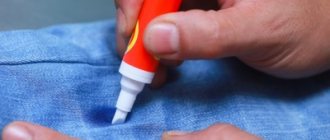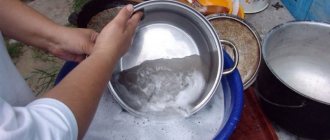Food is prepared on the kitchen stove every day. Most often, housewives touch handles and switches. We touch it in a hurry with a dirty hand, then when we fry, splashes of fat fly in different directions, dirtying our hands, or the milk runs away.
As a result, dirt and grease become clogged in small cracks, dents and crevices. Attempts to wash these stains with a sponge and detergent end in vain. And how do you clean it all up?
In this article, you will learn about cleaning methods in different ways, depending on the type of pens, the degree of contamination and affordability. You will learn which household chemicals are suitable for you, as well as some effective recipes that you can prepare at home yourself.
Methods for cleaning pens depending on the type
If the regulators are easily removed, they can be soaked or boiled in a solution to remove grease, and then easily clean off the residue with a brush.
If the handles on your stove are not removable, do not be upset, and for this case there will be a way; in this situation, sticks with cotton wool, again a toothbrush, which is no longer suitable for brushing teeth, gauze swabs and toothpicks are quite suitable for helping us.
Cleaning of fixed handles is carried out in the following sequence:
- take a product that contains chlorine;
- moisten a gauze swab in it and apply it to the hands (or spray it with a spray bottle);
- wait a few minutes;
- Next, we take a brush and clean it, in hard-to-reach places we go through with a cotton swab and a toothpick;
- Afterwards, use a sponge or cloth to wipe away any remaining dirt.
Main causes of malfunction
So, the household appliance decided to break down at the most inopportune moment. You can't bake the chicken, the buns have to wait too. Error codes appear on the control panel. There may be several reasons for such an unpleasant situation; they can only be determined by the results of professional diagnostics.
The oven does not turn on on an electric stove because:
- the wiring inside the unit is damaged;
- there is a malfunction of the heating element;
- the switch is broken;
- problems with the thermostat.
These breakdowns are often found in products from Beko, Indesit, Hansa, Gornje and some other companies. Let's look at the main causes of malfunctions, their symptoms and repair methods.
Types of pollution
Housewives in the kitchen most often have to deal with two types of dirty handles:
Light soiling of handles
If you pay attention to cleaning the handles and the entire stove after each cooking, keep your hands clean, and wipe off grease and burnt food in a timely manner, then the stains will be light and washing them will not be difficult.
ingrained fat
It happens that for various reasons, it is not possible to wash the handles and stove immediately after cooking, then the fat eats into the surface, and here other methods are needed.
How to remove the hinges?
Loops need to be removed in two cases:
- The door opens too hard.
- The door does not close completely.
The hinges are removed in the same way as when removing the door. But you will have to unscrew a few additional fasteners. During execution, the structure will be divided into several parts. One of them contains loops.
The oven may not open or close properly for the following reasons:
- The hinges are clogged or broken.
- The spring is too compressed or stretched.
- Too much debris accumulation.
For Bosch ovens, the spring is installed on both sides.
To avoid breaking hinges when cleaning doors, you must follow these rules:
- You need to unscrew and remove the hinges slowly, because if you do not calculate the force, the parts may break.
- Before removing the hinges, make sure that all screws have been removed. If only one remains, the fasteners may bend, and then you will have to change them.
- Do not use force to separate doors or glass. Companies make ovens so that all its parts can be removed without problems. If you feel resistance, you are most likely doing something wrong.
What products should I use to quickly clean stove handles?
For quick cleaning of handles, special wipes are suitable. They contain alcohol and citric acid, which successfully remove fat.
This also includes a spray product that you can buy in a store or prepare at home.
You can also use window cleaner by spraying the handles and then wiping them with a dry cloth. When using this method, the solution gets into hard-to-reach places, dissolving fat.
Cleaning with ammonia: how to use the composition?
Ammonia removes fat quickly and safely.
But it is not recommended to use it in its pure form. It is better to dilute alcohol and plain water in a separate container (in a ratio of 1 to 1). You can use either warm or cold water. Next, using cotton wool or a sponge, apply the resulting liquid to the plastic and leave for 5 minutes. The prepared solution will gradually corrode the contaminants. And then you just need to rinse the elements and wipe off any remaining dirt with a sponge. Ammonia is a good grease remover, so it will quickly and effectively help get your stove in perfect order.
Folk remedies
There are many grandmother's remedies that can be prepared at home from the most ordinary materials. They can always be found in almost every home.
Lemon juice
After processing this method, a pleasant lemon aroma will remain in the kitchen. We work with the use of this representative of citrus crops in the following sequence:
- We take one lemon, squeeze the juice out of it, then take a toothbrush (which we will no longer use to clean our teeth) and, dipping as necessary, clean our hands in a circular motion.
- If after this the dirt remains, additionally take baking soda and alternately dip it in juice and then in soda and clean off the remains.
- Afterwards, wash with a damp cloth or sponge and rub with a dry towel.
Important!
It is advisable to apply the solution in this way quickly while the quenching process is taking place.
Vinegar will get rid of odors and remove dangerous bacteria.
If the handles are removable, add a solution of equal proportions of water and vinegar in a saucepan, carefully remove the handles from the stove, lower them into the diluted liquid and put them on medium heat, bring to a boil and boil for 6-8 minutes. Then remove, cool and rub with a towel until dry. We install it in place.
If the handles are not removable, then in a spray bottle you need to dilute the composition of one part vinegar plus one part water, spray the handles generously, wait a while, and then wipe them with a clean, dry towel or paper napkin.
Laundry soap
For removable regulators, the following method is suitable:
- take a basin or large saucepan (the main thing is that everything fits there);
- rub laundry soap on a coarse grater into our container, fill it with hot water (about 80 degrees);
- stir until the soap dissolves (dishwashing detergent, washing powder);
- carefully lower our hands into the resulting solution and hold for 20-30 minutes (depending on the degree of contamination);
- then, after the time has passed, we find an unnecessary toothbrush and carefully clean the regulators on all sides and rinse with water.
After such cleaning, the removable regulators will again sparkle like new.
Advice!
If the contamination is very heavy, the soaking process should be increased to 10 hours.
This solution can also be used for handles that are not removable. To do this, use the non-soft side of the sponge, after applying the solution to it, and thoroughly rub the stained areas. And then remove the residue with a rag or paper towel.
Ammonia
This drug will help remove very strong and old stains if you work in the following sequence:
- dilute one part of water with one part of ammonia;
- dip a gauze swab and apply the product to the surface; We treat hard-to-reach places with a cotton swab and toothpick;
- wait a few seconds and wash off any remaining dirt with a clean, damp cloth.
Advice!
You can also use ammonia to clean furniture, dishes, taps in the kitchen and bathroom, and even items made of precious metals. It is advisable to carry out cleaning with this product while wearing a mask so as not to be poisoned by its vapors.
Installation of a gas stove with electric ignition
Top 5 best piezo lighters for a gas stove
Darina, Hansa, Ardo – so different and at the same time the same. The repair of gas stoves by Hephaestus is exactly like the repair of Ariston; gas stoves are made up of standard units. It is enough to look at a single device to understand the circuit. Have a reference book to help you properly maintain gas pressure. When set correctly, the flame is even and blue. Orange flashes indicate an imbalance in the fuel mixture. If the settings are incorrect, the flame will fail (especially typical for carob ovens).
For those who have read the reviews of the VashTekhnik portal regarding gas instantaneous water heaters, independent repair of gas stoves will seem like child’s play! You cannot do it yourself, but you can clean the device. The technician will have to clean candles, combustion sensors, burners, and sometimes nozzles. There are a lot of interesting things inside the gas stove. Anyone learning how to properly clean equipment should understand what we will see inside. Under the gas stove table:
- Burners. They are often bolted to the gas stove table. Each burner consists of a lid, a divider, and an injector (nozzle). They are not rigidly fastened under the table; each is fitted with a steel or copper tube; the fastening is carried out like an American one. You will need a key of approximately 13 to remove the products. It is more convenient to clean if something is clogged inside. Beware of tearing off the head or thread - you will have to replace it. After assembly, check the tightness by washing. The procedure involves applying foam to the disputed nodes.
- There are two candles around the perimeter of the burner. One serves as ignition (due to a piezoelectric element or an electronic circuit), the second is a thermocouple, included in the combustion control circuit. It's quite easy to distinguish. The high-voltage spark plug is covered with a ceramic caftan so that the spark does not strike below a predetermined level. When the arc flows, you can see: the tongue of the discharge licks the body of the burner. Gas stoves with electric ignition will be properly grounded by a technician. Beware of using plumbing connections or connectors pierced with metal threads. During installation, the hoses are separated from the riser by special gaskets. Failure to follow the rule will easily provoke an explosion in favorable situations. We wrote in more detail, we remind you again. The candle with a thermocouple is covered with a bronze caftan that conducts heat. The faster the semiconductors cool down, the flame goes out, and the protection that cuts off the gas supply will work more reliably.
- Most often there is a collector under the table. A thick tube from which a line goes to any burner. The gas flow is controlled by solenoid valves. The layer is usually equal to the number of burners. When the burner flame goes out, the rest will burn. The expediency of the decision can be challenged, but this is how it is done. Each solenoid valve contains an inductor. The thermocouple heats up, an EMF (tens of millivolts) appears, keeping the devices open. Complete activation procedure: turn the gas supply regulator, press down. We press the piezo ignition button, or the electronic circuit performs a set of procedures independently. We hold the handle for a fixed time. The thermocouple warms up, an EMF begins to be generated, the electromagnetic valve is held open due to the phenomenon discovered by Seebeck. As soon as the gas goes out, the sensor plug cools down and the gas supply stops. The process is inertial, we believe that the day is not far off, flame ionization sensors will begin to be used in gas stoves, allowing the protection to operate instantly.
- Similar to the gas manifold, there is a distribution valve panel inside. Single high-voltage wires run to each ignition electrode. Another way to distinguish a thermocouple: two wires with a thinner cross-section stretch to the sensor. The spark breakdown goes to the housing, the second ignition wire is superfluous. If the gas stove is deprived of grounding, we have a chance of getting an electric shock. Fatalities are possible - an additional reason to entrust the installation to a professional. The collector is connected via connectors. There is protection against incorrect orientation of the plug; you can easily mix up some places. When you open the burner, a spark will jump on another divider. It’s not very pleasant, a flash of flame is possible.
If the charge is generated by an electronic circuit, you will find a simple thyristor, diode, capacitor, and fuses inside. The circuit operates, powered by a capacitor charge with a subsequent burst of energy from the spark gap of the spark plug. Repair of electric ignition of a gas stove concerns the listed elements. The fault is easy to notice. Burnt elements are black or similar in color.
Household chemicals
For those who are used to buying cleaning products and detergents in household chemical stores, there is a huge variety and choice.
Household chemicals consist of various alkalis and solvents with the addition of soap and other ingredients. When using these tools, you should also not forget about the safety measures, which include the following:
- work with gloves;
- strictly follow the instructions;
- ventilate the room after treatment.
It is worth thinking before buying products in a store, as they are more expensive and not as effective as homemade products.
Fixed regulators
In order to clean non-removable regulators from greasy deposits and dirt, you need to use one of the following means:
- Aqueous ammonia 10% solution. Half the bottle must be diluted with water in equal quantities. After this, stir the mixture well and dip a cotton pad into it. Use it to clean the handles. To clean hard-to-reach places, use a cotton swab instead of a pad.
- Lemon juice must be squeezed into a container manually or using a special device. After that, dip a toothbrush into it and thoroughly rub your hands with it. After completing this process, you need to wipe the handles well, soaked in clean water, with a kitchen sponge.
- You can try to remove minor stains with wet wipes. If necessary, change the napkin to a clean one. It is worth considering that heavy contamination cannot be eliminated using this method.
- Vinegar essence. You need to combine 350 milliliters of clean water and 100 milliliters of vinegar essence in one container. After this, wet a sponge or soft cloth in the solution, and then thoroughly rub the contaminated surface. At the end of the process, wipe the regulators dry with a clean cloth.
- Laundry soap, grated. You need to grate 50 grams of soap on a large grater, and then pour hot water into it. Soak a sponge in the solution and rub the dirt with the hard side. Use a damp cloth to remove any remaining soap solution, and then wipe dry with a clean cloth.
- With the help of chemicals, you can clean dirt of any intensity in a short period of time. The drugs should be used only as described in the instructions. Quality substances are expensive.
- Ammonia-anise drops. Apply a small amount of drops to a cotton sponge and wipe the contaminated areas. Sponges need to be changed as soon as they become dirty. The panel should be wiped dry with a clean rag.
How to keep your pens always clean
To ensure that the control knobs are always clean and last longer, also to prevent the accumulation of germs, regularly, after each preparation of food, wipe them with special napkins or a damp cloth, dipping it in a detergent or cleaner, and keep your hands clean.
Choose the product that suits you best, follow our recommendations and do not forget about precautions. And let cooking bring you only joy and pleasure.
How do you like the article?
Precautionary measures
Even during a simple activity, you can injure yourself if you do not follow basic safety rules:
- Always wear thick rubber gloves to avoid injury to the skin of your hands and nails. Your skin will not dry out;
- Take your time when cleaning fixed surfaces. Sometimes fingers or nails involuntarily hit a hard surface, and the bruise can be severe;
- if your kitchen has an electric stove, unplug the plug from the socket before washing so that you do not accidentally get an electric shock;
- do not leave a pan with cooking detergent on the stove unattended;
- If you decide to resort to household chemicals, be sure to read the instructions and follow them when washing.
Shiny, clean handles immediately give the stove an attractive appearance and speak of the housewife’s neatness. To keep the products clean for a long time, after each cooking, wipe them with a damp cloth or a simple towel. Fresh fat will disappear instantly and will not have to be removed in the future. A stove that is maintained regularly will last for many years and will be in like new condition.
Larisa
Hello! My name is Lara. I am a housewife and I love being one. Don’t think that my responsibilities are only kitchen, washing, ironing and cleaning. I organize my time in a much more interesting way. One of my passions is this site for women. On it I publish topics that interest not only me, but also those around me.










